The East African nation of Kenya is home to extensive savannahs. The stunning grasslands, scrublands, and forests are home to lions, zebras, elephants, and wildebeest that wander free. The national Kenya flag, which has been flying with pride since 1963, is displayed in Nairobi, the country’s capital.
In this article, we’ll explore the history, significance, and symbolism of Kenya’s flag. Let’s start with a brief overview of the country and its geographical characteristics.
Kenya Geographical Characteristics
The history of the Kenya flag is strongly connected to the geographical and demographic characteristics of the country. The East African nation of Kenya is renowned for its historical parks, national parks, wildlife, and safari excursions. Nairobi, Kenya’s capital, is the country’s biggest and most developed metropolis. The only two recognized official languages are Swahili and English. Other than these, many languages are spoken by ethnic groups.
There is a tropical climate across the nation. While the seaside has an average temperature of 27 degrees, the mountains have a lower average temperature of 16 degrees. The western portion receives the most rainfall.
Country cuisine places a lot of emphasis on seafood. One of the items that are present in practically every meal is corn. Popular meals include Pilau and Sukuma Wiki.
The country keeps Eastern Africa Time throughout the year. There are no time modifications during daylight saving time in Kenya.
There are more than 40 different ethnic groupings and more than 60 different languages spoken in Kenya. There, almost everyone is bilingual in African languages. Kenyan youngsters have free access to education, but many are too busy to attend courses. They are working the land, caring for livestock, cooking, or getting water, and they support their family.
Kenyan culture places a lot of significance on music and storytelling. Tribes all around the nation have utilized songs, stories, and poetry for millennia to transmit their history, beliefs, and practices.
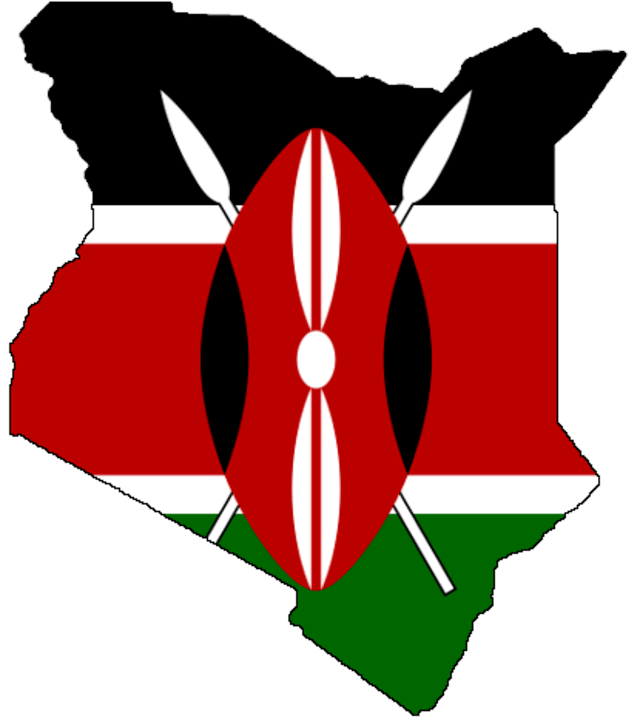
A Brief History Of Kenya
The Kenya flag has been modified and adjusted several times with the influence of Portugal, Britain, Germany, and Oman. People from all across Africa and the Middle East have long traveled and traded across Kenya due to its location between the Indian Ocean and Lake Victoria. As a result, there are now numerous different ethnic groups and languages.
According to scientists, the first human birthplace may have been in northern Kenya and Tanzania. In Kenya’s Turkana Basin, researchers recovered the remains of one of the oldest human forebears yet discovered.
The history of Kenya includes a lot of slavery. Many Kenyans were abducted and sold as slaves by Arabs, Europeans, and Americans during the 1600s and 1700s. Most nations had abolished slavery by the middle of the 19th century, but thousands of East Africans and Kenyans had already been transported to other nations by that time.
From 1920 to 1963, Kenya was a colony of the United Kingdom. It has been a republic ever since it gained its independence, with a president, a national legislature known as the Bunge, and a judicial system.
History & Development of Kenya Flag
From the 16th through the middle of the 20th century, Kenya’s coast was ruled by Portugal, Oman, Britain, and Germany. However, in the end, it was the country’s indigenous black population that decided on the images that are shown on the national Kenya flag. The Kenya African Union (KAU), the forerunner of the Kenya African National Union, was the dominant political force following World War II.
The party displayed its first Kenya flag on September 3, 1951. It was red and black, with a shield and arrow in the middle. The background was altered the next year to three evenly spaced horizontal black, red, and green stripes with the initials “KAU” in the middle of a white shield with crossed spears and arrows.
The black represented the native inhabitants, while the crimson symbolized the shared blood of all people. The guns served as a reminder that organized struggle served as the foundation for future self-government, while the color green represented the country’s bountiful soil.
On December 12, 1963, the country gained its independence from Great Britain, and the new Kenya flag was formally adopted. The party flag’s horizontal stripes include white fimbriation (thin borders) to differentiate the red from the black and green.
The shield was enlarged and modeled after those that have been carried by the Maasai tribe, which reflected the traditional methods of living in Kenya. While red represented the struggle for freedom, white stood for peace and harmony. Two spears were used in place of the arrow and spear from the original design.
Design Of Kenya Flag
Four colors make up the Kenya flag: black, red, green, and white. In the backdrop, there are tricolor bands that are black, white, and red with a white border around the red hue.
The broad white stripes are separated by smaller ones. A red shield with white and black crescents on either side called a Massai shield after the Maasai Tribe of Kenya appears in the center of the flag. Behind the shield, two white spears crossed. The flag of South Sudan has colors and symbolic meanings similar to the Kenya flag.
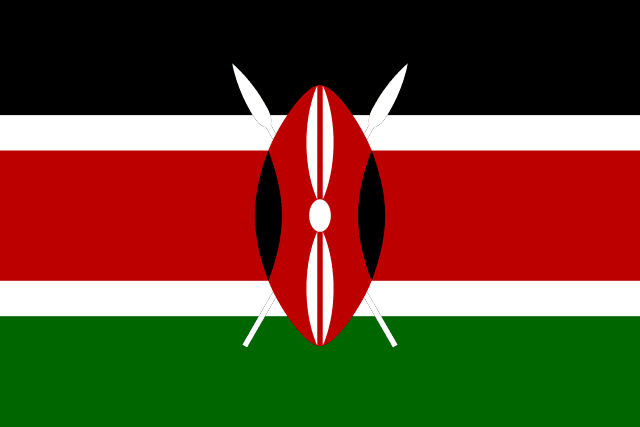
Kenya Flag Symbolism
The Kenyan flag colors and design both have important meanings. The Kenya African National Union, which led the campaign for Kenya’s independence, served as inspiration for the design. After the nation gained independence, symbols of peace, unity, and national defense were added. The nation’s people, its natural resources, and the blood poured during the war for independence are all symbolized by the flag’s colors.
In Nairobi, the capital of Kenya, the State House is topped by the flag of the country. William Ruto, the president of Kenya, resides in the State House.
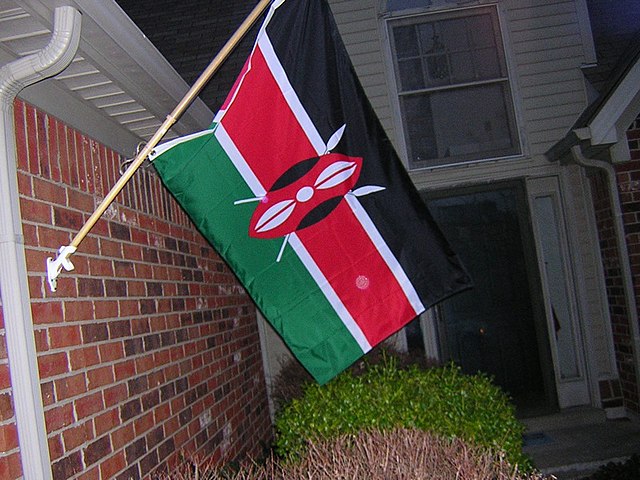
Kenya Military Flags
Three broad, horizontal red, light blue, and royal blue stripes make up the Defense Forces’ flag of Kenya. In the middle of the flag is a golden eagle with wings extended. A blue anchor and two crossed weapons are positioned behind the eagle. Directly below the eagle is a flag with the words “Kenya Armed Forces” on it.
The Kenya Air Force’s flag has a pale blue color. A bullseye in the national colors of black, red, and green is in the center.
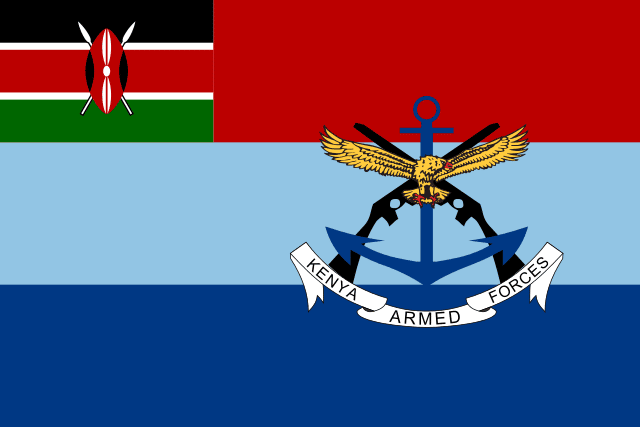
Coat Of Arms of Kenya
Yes, a large Masai shield is surrounded by two golden lions on either side of Kenya’s coat of arms. Each of the lions is holding a long, crimson spear. The shield has a white rooster in the middle clutching an ax and the colors of the Kenya flag. A banner with the phrase “Harambee,” the nation’s motto, which means “drawing together” or “cooperation,” is shown underneath the shield.
A silhouette of Mount Kenya may be seen in the distance. The nation’s agriculture is depicted with images of coffee, tea, pyrethrum (a unique pesticide), sisal (a vegetable fiber formed from agave leaves), corn, and pineapples.
Similar concepts are represented by the Kenya flag and the coat of arms. The two spears and the Masai shield stand for solidarity and the fight for freedom. The magnificent fauna of the nation and the bravery with which its citizens defend it is symbolized by the lions.
One of the largest lion populations in the world is found in Kenya’s Masai Mara National Reserve. The rooster has served as a representation of the KAU and KANU and stands for the beginning of a new day and hard labor.
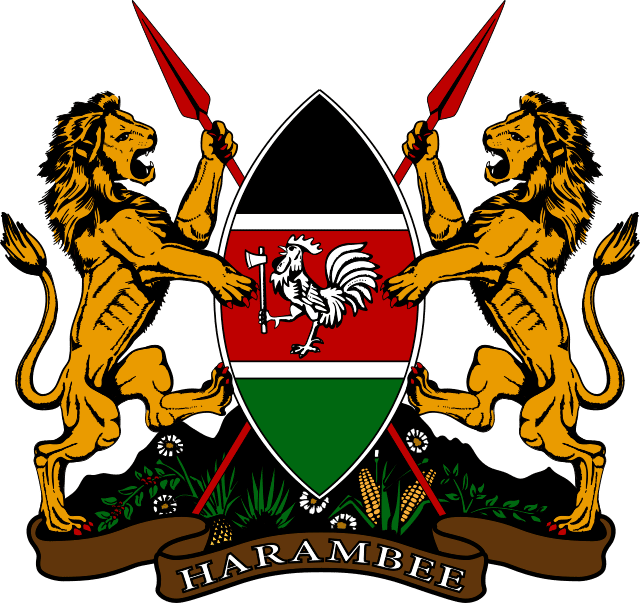
Kenya National Anthem
The Kenyan National Anthem’s melody is taken from an African song that is popular in Kenya’s Pokomo region. It is a traditional song that moms sing to their kids. A five-member panel, including Mr. Graham Hyslop, the then-Kenya Music Adviser, Mr. G. W. Senoga-Zake, Mr. Thomas Kalume, Mr. Peter Kibukosya, and Mr. Washington Omondi, composed the national anthem.
In Africa, this approach to creating a national song was entirely novel. It was the first time local artists had been tasked with writing an anthem for the government’s consideration. The committee said that the anthem’s presentation ought to incorporate Kenyan traditional music idioms. As a result, numerous songs from all around the nation were taken into consideration, and it was far from simple to locate those that would satisfy all the criteria outlined in the context of their employment as a national anthem.
The song needed to be the proper length and caliber while also having the required dignity. It had to have a personality that would make producing appropriate terms manageable. This was challenging given that the Commission intended to supply words in both Swahili and English. The song needed to be able to support the proper harmonization and orchestration for performance by a military band without losing the melody’s original tone.
It was anticipated that the lyrics would convey the collective people’s strongest beliefs and ambitions. Given the power of language to bring people together or drive them apart, tremendous care had to be taken to make the national anthem an unmistakable force for unity.
Bottom Line
Above this article, we explored the symbolism, history, and meaning of the Kenya flag which was formally approved on December 12, 1963. The colors of the flag are black, red, green, and white. The country’s black population is represented at the top by the color black, while the red and green hues stand in for the nation’s woods and plains and the valiant struggle and bloodshed of colonialism and slavery.